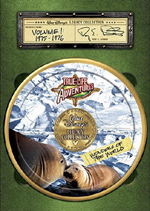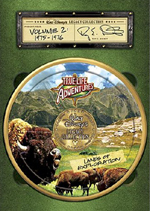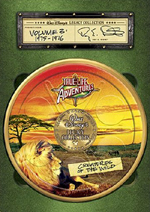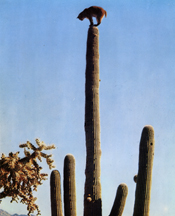Making movies. Enjoying movies. Remembering movies.
|
|
|
|
Related Articles:
|
Posted May 30, 2007 |
|
Walt Disney's "True-Life Adventures" On DVD |
By
William Kallay
 |
 |
 |
 |
Somewhere in our childhood minds, we can probably
playback 16mm reels of Walt Disney’s “True-Life Adventures.” Those scratched
prints featuring animals of many wild kingdoms were, for many of us, our
first glimpse into the world of nature. If we weren’t kids in the time these
were released in theatres, we probably caught one or a few of these in
classrooms on those special “movie days.” With tinny mono sound blasting
from a 16mm projector in the back of the classroom, these Disney films were
a welcome break from the occasionally monotonous school day.
Long before Discovery Channel took us to the farthest reaches of the planet,
Disney produced a number of theatrical films meant to educate and entertain
us about the life and death struggles of the animal kingdom. Now these
fascinating films, both feature-length and short, are available on an
excellent DVD collection. The series spans four (4) individual packages,
each containing two discs.
The transfer of each one of these films is exquisite. They’ve been digitally
cleaned and “restored.” I’m not sure if the original 16mm film elements were
restored, but the digital versions appear very clean and natural. There is
softness to the picture that is indicative of 16mm, but it’s not overly soft
and looks better than any print you may have seen in a classroom
environment. No scratches and no tinny sound here! The digital restoration
gives these films a natural film-look, as it should. The images are colorful
without being overbearing. The detail of heat rising from the hot African
plain, for instance, in “The African Lion” (Disc #3-“Creatures Of The
Wild”), is clearly seen on a television monitor. I don’t believe these films
have ever looked this good.
The Dolby Digital soundtrack, presented in mono, is very clear, and most of
the films are presented in the 1.33:1 aspect ratio (though the second disc
of “Nature’s Mysteries” [Volume 4], shows that a short segment of
"Secrets Of Life" was shot in CinemaScope.)
This DVD series is very extensive. I recommend that you explore each of
these discs. I will highlight certain features I enjoyed. There’s not a
single bad disc in the bunch. These discs will provide children with hours
of entertainment. These are recommended for children 9 and older, as some of
the sequences may upset younger children. Keep in mind that most of the
action in which animals are hunted or killed is mostly subdued and it’s
never shown for graphic effect.
Each disc begins with an introduction by Roy E. Disney. This is basically a
preview for upcoming DVDs that are a part of the Walt Disney Legacy
Collection. Mr. Disney then goes into short intros for the “True-Life
Adventure” series.
The discs are housed in film canister replicas, each with detailed artwork
from some of the films. The canisters are held in an attractive gold case
with a green felt interior. Disney seemed to put a lot of time an effort
into this endeavor.
The series includes “Wonders Of The World” (Volume 1), “Lands Of
Exploration” (Volume 2), “Creatures Of The Wild” (Volume 3), and “Nature’s
Mysteries” (Volume 4). Each disc features a number of either the feature
films and/or short films. Extra details about the contents of each of the
discs are included at the end of this review.
 |
Walt Disney and his filmmakers may have not been the first people to film
nature’s habitats. Some of the earliest films ever made were done in the
wild, including Robert Flaherty’s early documentaries like “Nanook Of The
North” (1922), certainly precluded any “True-Life Adventure” films. But it
was Disney’s remarkable team that brought the world of nature to movie
screens in a populist way. Sending a small army of cameramen and women
around the world, Disney captured nature like no other studio had before.
What’s more remarkable is that this was done in a time of limited air
travel, and with the lack of high tech equipment. Many lenses and cameras
had to be invented for these films.
What Disney film would be complete without a bit of Disney animation thrown
in for good measure? The “True-Life Adventures” began with the wonderful
opening of a spinning globe and animated titles. The painter’s brush enters
the frame and paints cartoon geography, then dissolves into the live-action
footage.
Each one of the “True-Life Adventure” films is filled with whimsy and danger
in the wild. There is little doubt that both children and adults will get a
kick out of a polar bear cub making snow balls to drop on a brother bear,
for instance. Clever editing helps to create a storyline and drama within
these films. In “Beaver Valley” (Volume 1, Disc 1), a group of animals warns
of a dangerous coyote’s immanent approach, for instance, almost saying,
“Look out!”
The animals are given human qualities through the addition of music by
Disney’s veteran composers, as well as sound effects. Hours and hours of
footage was shot for each one of the films, and then edited down to
reasonable running times. If the films featured simple narration and a
little bit of music, I doubt if they would’ve been very entertaining to most
audiences. With the music and Winston Hibler’s narration, the films come
alive.
There was probably some criticism directed toward the “True-Life Adventures”
for being playful. The music, Hibler’s narration and clever editing
sometimes added an atmosphere of frolics to the films. I can imagine some
hardcore critics, displeased with the films, saying that frivolity doesn’t
belong in a nature film. Yet that’s exactly the tone that works so well for
the series. Animals are playful, dangerous, sometimes silly and downright
fun to watch. With the filmmakers adding human elements to the animal
antics, oddly enough, an audience can identify with them. One minute, you
could be sitting on the edge of your seat watching a paca (a South American
rodent) get carried away by a jaguar, the next, watch a monkey tease a giant
lizard (“Jungle Cat,” Volume 3). These films cleverly mix in pathos with
laughter. The “True-Life Adventures” were made for mass audiences, as well
they should’ve been.
 |
Winston Hibler deserves a lot of credit for his narration. He was one of the
many talented individuals who performed multiple duties at the Walt Disney
Studios. One of them, of course, was the on-camera host of these nature
docs. His voice was comfortable and home spun. Listening to him, I imagine,
is just like listening to a favorite uncle or grandparent regale stories
about critters doing funny things in the wild. Hibler was a perfect match
for these films and the Disney style of the era. He taught you, without even
knowing it, about animals and their struggle for survival.
Disney has highlighted some of the filmmakers responsible for bringing the
“True-Life Adventures” to life. James Alger, director of many of the films,
is featured, as well as the Milottes and Crislers, who filmed many of these
in the wild.
Given the limitations of camera lenses and film stock when these films were
made, the filmmakers did a remarkable job in capturing the extensive
footage. There are shots of sunsets, frogs singing at nighttime, avalanches,
underwater scenes, and footage of insects, all captured on what some might
now consider ancient equipment. There was no high definition video done
here! The use of zoom lenses is something rare to see in this era (late
1940s-1960s), but is put to good use. The camerawork is extraordinary.
Occasionally, there are out-of-focus shots, but they’re used sparingly and
for use to tell the story. What impressed me more were the lengths that the
camera teams went to. There are some shots that are unbelievable in that the
cameramen/women perched themselves on cliffs, or often set themselves in
harm’s way via camouflage.
The films didn’t flinch at the brutal aspects of nature. Contrary to myth,
many of Disney’s films, especially ones that dealt with animals, were honest
in their portrayal of the life cycle. There has been a common misconception
that older Disney films are family friendly, kid friendly and bland
entertainment. Ever watch “Old Yeller”? The “True-Life Adventures” are no
exception. Though many of the films cut away from violent deaths of cute
little animals, some do not. The footage of a jaguar catching a paca, for
instance, isn’t gratuitous, but it may disturb younger children. Disney took
the correct approach in allowing audiences to decide for themselves whether
to watch the violence, or turn away from the screen. He was a realist in
this regard.
 |
One thought that crossed my mind while watching footage from, say, “The
Jungle Cat,” is that some of the jungles featured here are now probably
gone. Tremendous amounts of jungles and forests have given way to mankind’s
growth. When these films were made, there was conscious regard for
preserving nature. It’s too bad that mankind has encroached many of these
habitats, because they are extraordinary to see.
I’m glad to be able to experience Walt Disney’s award-winning “True-Life
Adventures” again. I was transported to those rainy days in which my
classmates and I cheered as our teacher rolled in the 16mm projector. There
is no reason why new generations of children can’t enjoy these films and
learn about nature. With the influx of programming on the Discovery and
National Geographic channels, one might think there are more than enough
nature shows on television. The beauty of the “True-Life Adventures” is that
they’re from a more innocent time, and they’re possibly more entertaining
than much of the programming we see today.
As Roy Disney comments, “They’re a little more naive, a little less cynical.
You can be watching Discovery Channel until your eyes blur over. But you
won’t be as entertained by that stuff as I think what we did.”
“Wonders Of The World” (Volume 1)
Disc 1
White Wilderness
Water Birds
Beaver Valley
Prowlers Of The Everglades
Sneak Peeks
Disc 2
Mysteries Of The Deep
Wonders Of The Water Worlds
The Crisler Story
Backstage With Roy Disney At Disney’s Animal Kingdom: Birds
Tribute To James Alger
Filmmaker’s Journal
Collector’s Corner
Original Theatrical Trailers
“Lands Of Exploration” (Volume 2)
Disc 1
Introduction By Roy Disney
The Living Desert
The Vanishing Prairie
Seal Island
Disc 2
Islands Of The Sea
Nature’s Strangest Creatures
Prairie
Behind The True-Life Cameras
Backstage With Roy Disney At Disney’s Animal Kingdom: Desert Insects
Backstage With Roy Disney At Disney’s Animal Kingdom: Snakes
Filmmaker’s Journal
Collector’s Corner
Trailers & Promos
“Creatures Of The Wild” (Volume 3)
Disc 1
Introduction By Roy Disney
The African Lion
Jungle Cat
Bear Country
Disc 2
Olympic Elk
Cameras In Africa
The Yellowstone Story
Tribute To The Milottes
Backstage With Roy Disney At Disney’s Animal Kingdom: Elephants
Backstage With Roy Disney At Disney’s Animal Kingdom: Cheetah Medical Exam
Filmmaker’s Journal
Collector’s Corner
Trailers & Promo
“Nature’s Mysteries” (Volume 4)
Disc 1
Introduction By Roy Disney
Secrets Of Life
Perri
Disc 2
Nature’s Half Acre
Searching For Nature’s Mysteries
Adventure In Wildwood Heart
Backstage With Roy Disney At Disney’s Animal Kingdom: Butterflies
Tribute To Winston Hibler
Filmmaker’s Journal
Collector’s Corner
Original Theatrical Trailers
True-Life Adventures
Buena Vista Home Entertainment
Catalog Numbers 51114, 51115, 51116, 52543
Region 1
1.33:1
Dolby Digital 2.0
DVD Release Dates: December 5, 2006
$32.99 each
Not rated
Two DVD-9 Discs (per box)
2006
169 minutes (Volumes 1, 2 & 4), 204
minutes (Volume 3)
Color
Directors: James Alger, Ben Sharpsteen, Paul Kenworthy Jr., Ralph Wright
Cast: Winston Hibler, James Alger, Walt Disney and animals of the wild
Special thanks to Mac McLean
IMAGES: © Disney. All rights reserved.
